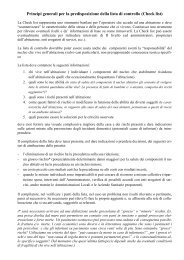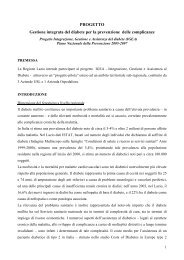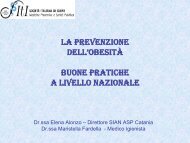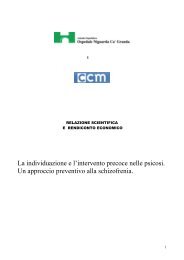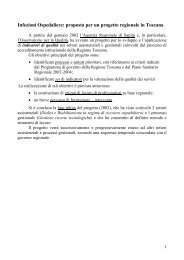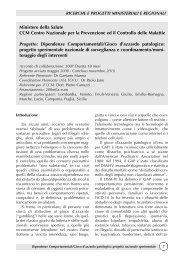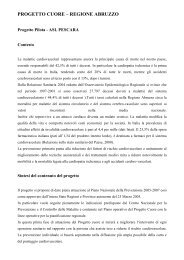Gaining health : analysis of policy development in European ...
Gaining health : analysis of policy development in European ...
Gaining health : analysis of policy development in European ...
Create successful ePaper yourself
Turn your PDF publications into a flip-book with our unique Google optimized e-Paper software.
Chapter 4<br />
166<br />
A first <strong>policy</strong> for older people was published <strong>in</strong> 1988, The<br />
years ahead: a <strong>policy</strong> for the elderly. Its ma<strong>in</strong> recommendations<br />
– to ma<strong>in</strong>ta<strong>in</strong> or restore older people to their home<br />
environment, to encourage the care <strong>of</strong> older people <strong>in</strong> the<br />
community and to provide high-quality hospital and residential<br />
care when necessary – were later recognized <strong>in</strong> the<br />
1994 broad <strong>health</strong> strategy and the 1995 <strong>health</strong> promotion<br />
strategy.<br />
Although these broader <strong>health</strong> strategies <strong>of</strong> the mid-1990s<br />
identified older people as a priority population group with<br />
particular <strong>health</strong> promotion needs, their ma<strong>in</strong> focus was<br />
on the under-65s. Furthermore, a study <strong>of</strong> older people<br />
found that almost half <strong>of</strong> the respondents had major <strong>health</strong><br />
problems, and one <strong>in</strong> four suffered from psychological<br />
distress provoked more by the onset <strong>of</strong> poor <strong>health</strong> than<br />
old age itself (40). In 1995, therefore, the National Council<br />
on Age<strong>in</strong>g and Older People proposed the <strong>development</strong><br />
<strong>of</strong> a <strong>health</strong>y age<strong>in</strong>g programme to improve life expectancy<br />
and the <strong>health</strong> status <strong>of</strong> people at age 65 and beyond, and<br />
to improve the lives and autonomy <strong>of</strong> older people already<br />
affected by illness.<br />
The programme had three strands, the first <strong>of</strong> which was a<br />
<strong>health</strong> promotion strategy for older people: Add<strong>in</strong>g years to<br />
life and life to years (41). This strategy, formulated <strong>in</strong> association<br />
with the DoHC, marked the launch<strong>in</strong>g <strong>of</strong> the Council’s<br />
Healthy Age<strong>in</strong>g programme. It was seen as a further<br />
ref<strong>in</strong>ement <strong>of</strong> the 1994 <strong>health</strong> and the 1995 <strong>health</strong> promotion<br />
policies, and a follow-up to the 1988 <strong>policy</strong> for older<br />
people. The ma<strong>in</strong> objectives are to improve:<br />
• life expectancy at age 65 and beyond;<br />
• the <strong>health</strong> status <strong>of</strong> people aged 65 and beyond; and<br />
• the lives and autonomy <strong>of</strong> older people who are already<br />
affected by illness and impairment.<br />
It recognizes that older people are sometimes left out<br />
<strong>of</strong> more general <strong>health</strong> education and <strong>health</strong> promotion<br />
<strong>in</strong>terventions, and that ow<strong>in</strong>g to the broad diversification<br />
<strong>of</strong> older people <strong>in</strong> terms <strong>of</strong> <strong>health</strong> status and dependency<br />
levels, different approaches may be needed than those for<br />
younger age groups.<br />
CVD accounts for 48% <strong>of</strong> deaths among those aged 65<br />
years and over, and cancer is the second most common<br />
cause <strong>of</strong> death <strong>in</strong> this age group. The strategy sets quantified<br />
targets to reduce the death rates from these causes<br />
among older people and to deal with risks such as smok<strong>in</strong>g<br />
and hypertension. It also deals with broader determ<strong>in</strong>ants<br />
<strong>of</strong> <strong>health</strong>, <strong>in</strong>clud<strong>in</strong>g tackl<strong>in</strong>g ageism and support<strong>in</strong>g participatory<br />
structures such as the Irish Senior Citizens National<br />
Parliament.<br />
The second strand <strong>in</strong>volved the <strong>development</strong> <strong>of</strong> an <strong>in</strong>formation<br />
and support network, <strong>in</strong>clud<strong>in</strong>g a database on <strong>health</strong><br />
promotion practice and a fact file series, Age<strong>in</strong>g <strong>in</strong> Ireland.<br />
The third strand aimed to evaluate new or exist<strong>in</strong>g <strong>in</strong>itiatives,<br />
start<strong>in</strong>g with a home accident prevention programme,<br />
a <strong>health</strong> education programme <strong>in</strong> the north-east and an<br />
<strong>in</strong>tersectoral programme, <strong>in</strong>volv<strong>in</strong>g the Irish Sports Council<br />
(“Go for life”), encourag<strong>in</strong>g physical activity.<br />
As is the usual practice, the strategy takes fully <strong>in</strong>to account<br />
similar <strong>in</strong>ternational <strong>development</strong>s. It also makes provision<br />
for evaluation <strong>of</strong> <strong>in</strong>terventions.<br />
2.8. Broad <strong>in</strong>tersectoral policies with a <strong>health</strong><br />
component<br />
A number <strong>of</strong> important <strong>development</strong>s with implications<br />
for social <strong>in</strong>clusion issues, <strong>in</strong>clud<strong>in</strong>g efforts to reduce <strong>health</strong><br />
<strong>in</strong>equalities, took place <strong>in</strong> Ireland <strong>in</strong> 2006 and early 2007.<br />
• A new 10-year Framework Social Partnership Agreement<br />
for 2006–2015, Towards 2016, was published <strong>in</strong><br />
June 2006.<br />
• The National Report on Strategies for Social Protection<br />
and Social Inclusion was forwarded to the <strong>European</strong><br />
Commission <strong>in</strong> September 2006, outl<strong>in</strong><strong>in</strong>g key objec-<br />
Case studies: <strong>policy</strong> <strong>development</strong> <strong>in</strong> countries for tackl<strong>in</strong>g noncommunicable diseases



